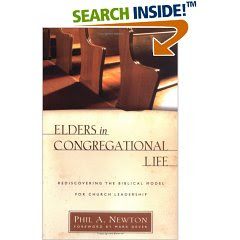 The recent surge in reformed theology among evangelicals has also led to an increased interest in a plurality of elders as leaders of the church. This relationship may simply be from the fact that many reformed writers have come from a presbyterian background that emphasizes the plural elder model, or from the community emphasis that accompanies reformed teaching. Regardless of the reason for the interest, it remains that the plural elder model is becoming increasingly popular, even in some Baptist churches.
The recent surge in reformed theology among evangelicals has also led to an increased interest in a plurality of elders as leaders of the church. This relationship may simply be from the fact that many reformed writers have come from a presbyterian background that emphasizes the plural elder model, or from the community emphasis that accompanies reformed teaching. Regardless of the reason for the interest, it remains that the plural elder model is becoming increasingly popular, even in some Baptist churches.
Phil Newton, in Elders in Congregational Life argues that the plural elder model, though not the norm in Baptist life, has always existed in Baptist life. Quoting current and former Baptist leaders such as John Piper,Mark Dever,Benjamin Keach and W.B. Johnson as well as ancient and modern confessions of faith, Newton convincingly shows that plural elders have always been present in a minority among Baptists. Building on that foundation, the author aims to show that the minority opinion was the correct representation of the New Testament church.
Here is precisely the wisdom of the New Testament pattern of plural eldership. No one man possesses all the gifts necessary for leading a congregation…The pastor is first among equals in authoiry –first by virtue of the church’s call and his training and gifts, but equal in that he is not a “Lone Ranger” figure in church leadership.
The major weakness of the book is the belief that elders (and only elder leadrship) can safeguard against pride in the ministry in a greater way than deacon-led congregations.
Often the church staff or pastor or deacon chairman receives undue attention by the congregation. That approach to church leadership has long crippled churches. But the goal of elder plurality dismantles crippling power structures, redirection attention to the glory of Christ. Plurality thus humbles the natural pride involved in leadership, and gives a conctant reminder that the church exists for the glory of Christ, not the aggrandizement of one man, or a few men.
Elders are given the authority to rule (just as deacons are in other settings), and the temptations that come with leadership in the church exist regardless of the title given to the office. It is naive, at best, to suggest that a body of elders is immune from the temptations inherent within leadership.
That withstanding, however, this book is a valuable read for anyone interested in the subject of plural elders. Also, this book should serve as a warning to pastors with too much authority. Newton writes, churches that have a pastor as an authority above others have a disproportionately high number of moral failures at the top level of leadership. Whether you agree with Newton’s survey of the Scriptures, everyone should be concerned about the lack of accountability that is often present within the church.
Newton gives some great hands on tips to apply the teachings of his book and to institute plural elders in the church. Even if you do not plan to lead toward plural eldership in your church, you should plan to institute accountability for those serving in leadership within the church as a failsafe for the church and her leaders.

